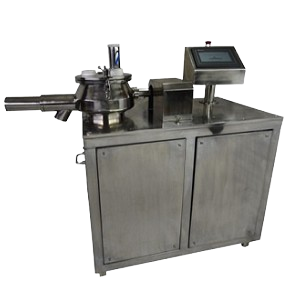
Unveiling the Power of Rapid Mixer Granulators
Granulation: The Art of Transforming Powders into Precise Granules
In the world of pharmaceuticals and manufacturing, granulation is a pivotal process. It’s the art of molding powdery or solid substances into defined granules, ushering in a new era of practical and efficient materials. These granules typically range in size from 0.2 to 0.4 mm, and they come to life through the amalgamation of fine particles, which bind together with a purpose.
Granulation: The Art of Transforming Powders into Precise Granules
In the world of pharmaceuticals and manufacturing, granulation is a pivotal process. It’s the art of molding powdery or solid substances into defined granules, ushering in a new era of practical and efficient materials. These granules typically range in size from 0.2 to 0.4 mm, and they come to life through the amalgamation of fine particles, which bind together with a purpose.
Why Granulation Matters
Granulation isn’t just a creative process; it’s a necessity with multiple benefits:
- Preventing Segregation: Bid farewell to the age-old problem of powders separating based on size or density differences. Granulation ensures your mix remains cohesive and consistent, eliminating the threat of component segregation.
- Enhancing Flow: Tired of dealing with powders that seem to have a mind of their own? Granulation smooths the path, promoting seamless flow of powders.
- Uniformity: Unify your mix with precision. Granulation ensures each granule houses the perfect blend of your mix’s constituents, spelling the end of content uniformity issues.
- Dust-Free Formulations: Granulation seals away dust, granting you a cleaner, safer working environment.
- Improved Compaction: Your mix deserves the best, and granulation elevates it. Granules, particularly those derived from cohesive systems, boast superior compaction characteristics, thanks to their rounder, denser nature.
Three Distinct Granulation Techniques
- Wet Granulation: The tried-and-true method for creating granules through moisture and binding agents. Ideal for cohesive or hard-to-compact materials.
- Dry Granulation: When moisture sensitivity or high drug dosage enter the picture, dry granulation takes the lead.
- Direct Compression: The choice when simplicity and cost-efficiency are paramount.
When to Opt for Dry Granulation
Select dry granulation when you’re working with high drug doses, materials that don’t compress well after wet granulation, heat-sensitive or moisture-sensitive drugs. Dry granulation thrives in these challenging scenarios.
Steps in Dry Granulation
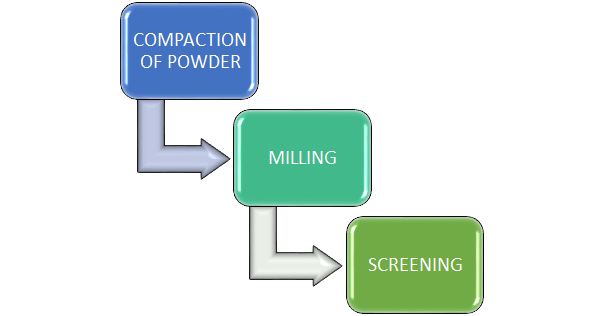
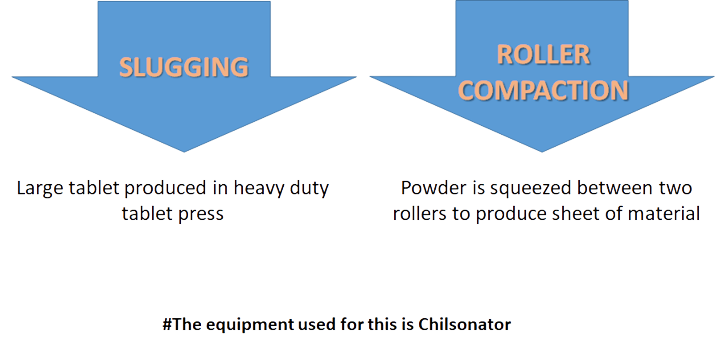
But how does dry granulation work its magic? Here’s the breakdown:
Mixing: Begin with dry mixing, ensuring all ingredients are well-dispersed.
Impeller & Chopper: The heart of the rapid mixer granulator (RMG). The impeller and chopper work in tandem to uniformly mix wet granules and break them into the desired size.
Speed Variation: Initially, the impeller and chopper operate at low speeds during binder addition. As the wet mass forms, they shift to high-speed mode, crafting the ideal granule size.
Steps in Wet Granulation
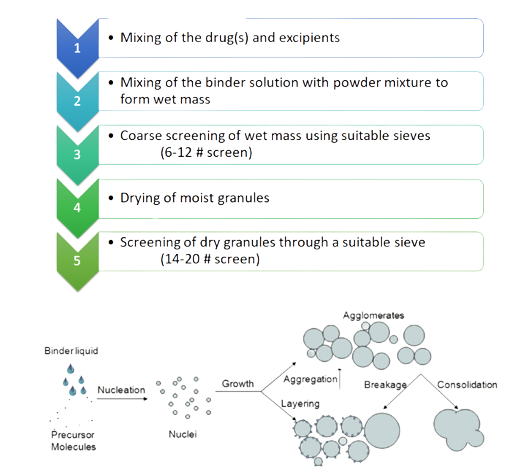
Limitation of Wet Granulation
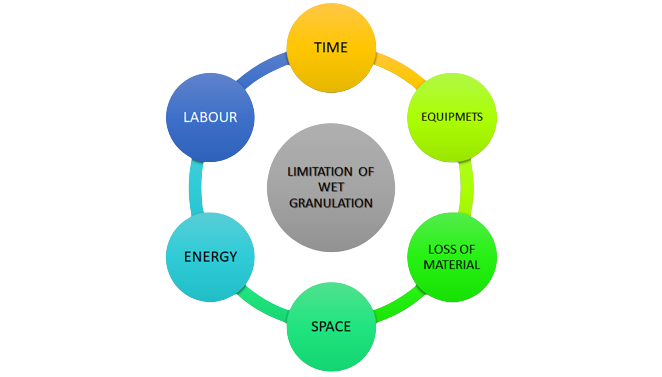
Inside the High Shear Mixture Granulator (HSMG)
The High Shear Mixture Granulator, a stalwart of the pharmaceutical industry, excels in mixing, agitation, and shear action to create granules fit for compression. Known by various names, such as High Shear Granulation Machine, Dry Powder Granulator, Wet Granulator, and more, the RMG is a versatile powerhouse.
The RMG’s Principle in Action
The RMG relies on agitation and tumbling, with the impeller ensuring uniform mixing of wet granules and the chopper reducing particle size. Dry mixing at high speed follows the addition of all ingredients. These parameters, tailored to each product, are documented during batch validation.
Key Components of the HSMG
- Impellers: These blades, designed with precision, facilitate material movement and size reduction in the granules.
- Chopper: Featuring sharp blades, the chopper cuts wet lumps into smaller pieces, whose size is controlled by its speed.
- Discharge Port: Controlled by pneumatic cylinder, this port facilitates easy unloading of granules.
- Pneumatic System: Governs the operation of discharge valves, chopper drives, and impeller drives, safeguarding against cross-contamination.
- Mixing Chamber (Bowl): This SS316 chamber, with its conical top, aids the mixing of cohesive powders while ensuring purity.
- Cone Mill: Employed to break up lumps during wet mixing, enhancing drying efficiency.
Working Magic with RMG
In the RMG, granules take shape as impellers send the mixture into a spinning, tumbling motion. The chopper comes to the rescue by breaking up large lumps, and during binder solution addition, both the impeller and chopper operate at slow speeds. As the wet mass forms, they shift to high speed, crafting the granules to the desired size.
Applications and Advantages
The Rapid Mixer Granulator finds its prime use in the tablet manufacturing process, offering:
- Homogeneous Mixing
- Controlled Granule Size
- Drastic Reduction in Processing Time
Pros and Cons
Pros:
- Rapid Mixing, Massing, and Granulation
- Gravity-Loaded
- Consistent Formulation
- Rapid Granule Formation
- Reduced Wetting and Swift Drying
- Homogeneous Dry Mixes
- Quick Color Distribution
- Easy to Clean
- GMP-Standardized
- Self-Discharge
- Large-Scale Mixing in Minimal Time
Cons:
- High Noise Levels
- Space-Intensive
- Elevated Cost
- Working Height Challenges
Watch in action Rapid Mixer Granulator (Zeolite & Alumina Mixing) (youtube.com)
Advancements in Heterogeneous Catalyst Granulation Techniques: Enhancing Catalytic Efficiency and Performance
A Heterogeneous Catalyst Granulator is a piece of equipment used in industrial settings to manufacture catalyst granules. These granules are essential components in many chemical processes where catalysis is required for reactions to occur. Here’s an overview of the functionalities and importance of a heterogeneous catalyst granulator:
Granulation Process: The granulator takes precursor materials or catalyst components and processes them into granules of specific sizes and shapes. This process is crucial for ensuring uniformity and consistency in the catalyst particles, which is essential for their performance in catalytic reactions.
Controlled Particle Size: The granulator allows for precise control over the size distribution of the catalyst granules. This control is critical because the catalytic activity and selectivity of heterogeneous catalysts often depend on the size and surface area of the particles.
Uniformity and Stability: By using a granulator, manufacturers can achieve uniformity in catalyst properties throughout the production batch. Additionally, the granulation process can enhance the stability and mechanical strength of the catalyst particles, making them more resistant to abrasion and attrition during use.
Tailored Properties: A heterogeneous catalyst granulator enables the incorporation of various additives, promoters, or supports into the catalyst formulation. This allows for the tailoring of the catalyst properties to meet the specific requirements of the target chemical process, such as improved activity, selectivity, or resistance to poisoning.
Increased Surface Area: Granulation can increase the surface area of the catalyst particles, which is beneficial for enhancing the contact between the reactants and the active sites on the catalyst surface. This increased surface area can lead to higher catalytic activity and efficiency in chemical reactions.
Scalability: Heterogeneous catalyst granulators are designed to operate efficiently at different production scales, ranging from laboratory-scale research to large-scale industrial production. This scalability is essential for transitioning catalyst formulations from the development stage to commercial manufacturing.
In summary, a heterogeneous catalyst granulator plays a crucial role in the production of catalyst granules with controlled properties, uniformity, and stability, which are essential for optimizing catalytic performance in various industrial processes.
